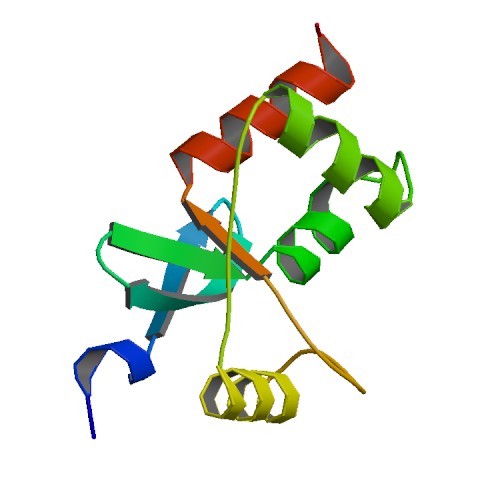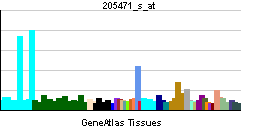DACH1
| Dachshund homolog 1 (Drosophila) | |||||||||||||
|---|---|---|---|---|---|---|---|---|---|---|---|---|---|
 PDB rendering based on 1l8r. | |||||||||||||
| |||||||||||||
| Identifiers | |||||||||||||
| Symbols | DACH1 ; DACH; FLJ10138 | ||||||||||||
| External IDs | Template:OMIM5 Template:MGI HomoloGene: 7288 | ||||||||||||
| |||||||||||||
| RNA expression pattern | |||||||||||||
 | |||||||||||||
 | |||||||||||||
| More reference expression data | |||||||||||||
| Orthologs | |||||||||||||
| Template:GNF Ortholog box | |||||||||||||
| Species | Human | Mouse | |||||||||||
| Entrez | n/a | n/a | |||||||||||
| Ensembl | n/a | n/a | |||||||||||
| UniProt | n/a | n/a | |||||||||||
| RefSeq (mRNA) | n/a | n/a | |||||||||||
| RefSeq (protein) | n/a | n/a | |||||||||||
| Location (UCSC) | n/a | n/a | |||||||||||
| PubMed search | n/a | n/a | |||||||||||
Dachshund homolog 1 (Drosophila), also known as DACH1, is a human gene.[1]
This gene is similar to the Drosophila melanogaster dachshund gene, which encodes a nuclear factor essential for determining cell fates in the eye, leg, and nervous system of the fly. It is a member of the Ski gene family and is thought to be involved in eye development. Four alternatively spliced transcripts encoding different isoforms have been described for this gene.[1]
References
Further reading
- Hammond KL, Hanson IM, Brown AG; et al. (2003). "Mammalian and Drosophila dachshund genes are related to the Ski proto-oncogene and are expressed in eye and limb". Mech. Dev. 74 (1–2): 121–31. PMID 9651501.
- Hammond KL, Lettice LA, Hill RE; et al. (1999). "Human (DACH) and mouse (Dach) homologues of Drosophila dachshund map to chromosomes 13q22 and 14E3, respectively". Genomics. 55 (2): 252–3. doi:10.1006/geno.1998.5662. PMID 9933575.
- Kozmik Z, Cvekl A (1999). "Localization of the human homologue of the Drosophila dachshund gene (DACH) to chromosome 13q21". Genomics. 59 (1): 110–1. doi:10.1006/geno.1999.5797. PMID 10395809.
- Kozmik Z, Pfeffer P, Kralova J; et al. (1999). "Molecular cloning and expression of the human and mouse homologues of the Drosophila dachshund gene". Dev. Genes Evol. 209 (9): 537–45. PMID 10502110.
- Machon O, Backman M, Julin K, Krauss S (2001). "Yeast two-hybrid system identifies the ubiquitin-conjugating enzyme mUbc9 as a potential partner of mouse Dac". Mech. Dev. 97 (1–2): 3–12. PMID 11025202.
- Ayres JA, Shum L, Akarsu AN; et al. (2001). "DACH: genomic characterization, evaluation as a candidate for postaxial polydactyly type A2, and developmental expression pattern of the mouse homologue". Genomics. 77 (1–2): 18–26. doi:10.1006/geno.2001.6618. PMID 11543628.
- Ozaki H, Watanabe Y, Ikeda K, Kawakami K (2002). "Impaired interactions between mouse Eyal harboring mutations found in patients with branchio-oto-renal syndrome and Six, Dach, and G proteins". J. Hum. Genet. 47 (3): 107–16. PMID 11950062.
- Kim SS, Zhang RG, Braunstein SE; et al. (2003). "Structure of the retinal determination protein Dachshund reveals a DNA binding motif". Structure. 10 (6): 787–95. PMID 12057194.
- Ikeda K, Watanabe Y, Ohto H, Kawakami K (2002). "Molecular interaction and synergistic activation of a promoter by Six, Eya, and Dach proteins mediated through CREB binding protein". Mol. Cell. Biol. 22 (19): 6759–66. PMID 12215533.
- Strausberg RL, Feingold EA, Grouse LH; et al. (2003). "Generation and initial analysis of more than 15,000 full-length human and mouse cDNA sequences". Proc. Natl. Acad. Sci. U.S.A. 99 (26): 16899–903. doi:10.1073/pnas.242603899. PMID 12477932.
- Wu K, Yang Y, Wang C; et al. (2004). "DACH1 inhibits transforming growth factor-beta signaling through binding Smad4". J. Biol. Chem. 278 (51): 51673–84. doi:10.1074/jbc.M310021200. PMID 14525983.
- Nobrega MA, Ovcharenko I, Afzal V, Rubin EM (2003). "Scanning human gene deserts for long-range enhancers". Science. 302 (5644): 413. doi:10.1126/science.1088328. PMID 14563999.
- Li X, Oghi KA, Zhang J; et al. (2003). "Eya protein phosphatase activity regulates Six1-Dach-Eya transcriptional effects in mammalian organogenesis". Nature. 426 (6964): 247–54. doi:10.1038/nature02083. PMID 14628042.
- Ota T, Suzuki Y, Nishikawa T; et al. (2004). "Complete sequencing and characterization of 21,243 full-length human cDNAs". Nat. Genet. 36 (1): 40–5. doi:10.1038/ng1285. PMID 14702039.
- Dunham A, Matthews LH, Burton J; et al. (2004). "The DNA sequence and analysis of human chromosome 13". Nature. 428 (6982): 522–8. doi:10.1038/nature02379. PMID 15057823.
- Gerhard DS, Wagner L, Feingold EA; et al. (2004). "The status, quality, and expansion of the NIH full-length cDNA project: the Mammalian Gene Collection (MGC)". Genome Res. 14 (10B): 2121–7. doi:10.1101/gr.2596504. PMID 15489334.
- Martini SR, Davis RL (2005). "The dachshund gene is required for the proper guidance and branching of mushroom body axons in Drosophila melanogaster". J. Neurobiol. 64 (2): 133–44. doi:10.1002/neu.20130. PMID 15818552.
- Rual JF, Venkatesan K, Hao T; et al. (2005). "Towards a proteome-scale map of the human protein-protein interaction network". Nature. 437 (7062): 1173–8. doi:10.1038/nature04209. PMID 16189514.
- Wu K, Li A, Rao M; et al. (2006). "DACH1 is a cell fate determination factor that inhibits cyclin D1 and breast tumor growth". Mol. Cell. Biol. 26 (19): 7116–29. doi:10.1128/MCB.00268-06. PMID 16980615.
| This protein-related article is a stub. You can help Wikipedia by expanding it. |